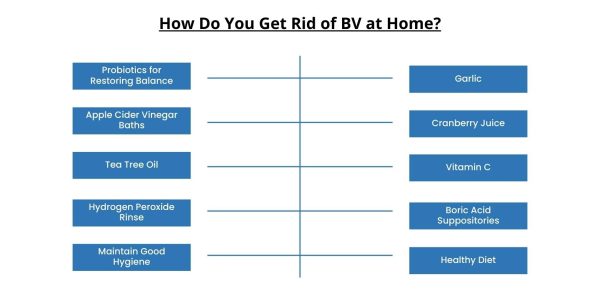Bacterial Vaginosis (BV) is a common yet often misunderstood condition affecting approximately 29% of women in the United States, according to the CDC. While BV is not typically considered a serious health issue, it can cause uncomfortable symptoms like unusual discharge, odor, and irritation.
If left untreated, it might lead to more significant health problems, including an increased risk of sexually transmitted infections (STIs) and complications during pregnancy. Understanding and addressing BV naturally can help maintain vaginal health and prevent these potential complications.
A Closer Look at Bacterial Vaginosis
Bacterial Vaginosis (BV) is an imbalance of the natural bacteria found in the vagina. Normally, the vagina has a mix of “good” bacteria (lactobacilli) and “bad” bacteria (anaerobes). When the bad bacteria outnumber the good, BV occurs. This condition is not classified as an infection but rather a disruption of the natural vaginal flora.
Common symptoms include a thin, grayish-white discharge with a fishy odor, especially after intercourse, itching, and burning during urination. Although BV can be uncomfortable and inconvenient, it is generally treatable with lifestyle changes and natural remedies. Understanding BV is the first step towards managing and preventing it effectively.
Why Do I Get BV So Often?
Frequent occurrences of Bacterial Vaginosis (BV) can be frustrating and puzzling. Several factors may contribute to recurrent BV, including sexual activity, douching, and changes in hormone levels.
Engaging in unprotected sex or having multiple sexual partners can introduce new bacteria into the vaginal environment, disrupting the natural balance. Douching, although intended to clean, actually removes beneficial bacteria and disrupts the pH balance of the vagina, making it more susceptible to BV.
Hormonal fluctuations, such as those experienced during menstrual cycles, pregnancy, or menopause, can also affect the vaginal flora.
Symptoms and Causes
Bacterial Vaginosis (BV) occurs when there is an imbalance in the natural bacteria of the vagina. This imbalance can lead to various uncomfortable symptoms and is influenced by several factors. Recognizing the causes and symptoms can help in identifying and managing BV more effectively.
Symptoms of BV:
- Thin, grayish-white vaginal discharge
- Strong, fishy odor, particularly after intercourse
- Vaginal itching or irritation
- Burning sensation during urination
- Mild pelvic discomfort
Causes of BV:
- Overgrowth of harmful bacteria (anaerobes)
- Decrease in beneficial bacteria (lactobacilli)
- Unprotected sexual activity
- Multiple sexual partners
- Douching
- Hormonal changes (menstrual cycle, pregnancy, menopause)
- Use of intrauterine devices (IUDs)
BV VS Yeast Infection
BV and yeast infections are both common vaginal conditions, but they have distinct differences in their causes, symptoms, and treatments. While BV is caused by an imbalance of bacteria in the vagina, yeast infections result from an overgrowth of the fungus Candida. Recognizing the differences between these conditions is crucial for effective treatment and prevention.
What Happens if You Don’t Treat BV?
If left untreated, Bacterial Vaginosis (BV) can lead to several complications that extend beyond the discomfort of its symptoms. Untreated BV can increase the risk of contracting sexually transmitted infections (STIs), including HIV, due to the compromised state of the vaginal flora.
Additionally, BV can cause complications during pregnancy, such as premature birth, low birth weight, and infections in the newborn. It can also lead to pelvic inflammatory disease (PID), a condition that can result in infertility if not properly addressed.
Therefore, timely treatment of BV is crucial to prevent these potentially serious health issues and maintain overall reproductive health.
Can You Get Rid of BV Without Antibiotics?
It is possible to get rid of Bacterial Vaginosis (BV) without antibiotics by focusing on restoring the natural balance of bacteria in the vagina. This involves adopting habits and lifestyle changes that promote a healthy vaginal environment.
Understanding the factors that contribute to BV and taking steps to mitigate them can significantly reduce the incidence of this condition. While antibiotics are a common treatment, exploring alternative methods to manage and prevent BV can be equally effective for many women.
How Do You Get Rid of BV at Home?
Getting rid of Bacterial Vaginosis (BV) at home involves adopting natural and holistic approaches that restore the natural balance of bacteria in the vagina. There are numerous bacterial vaginosis home remedies that women have found effective.
By focusing on natural remedies for bacterial vaginosis and incorporating specific lifestyle changes, it is possible to manage and eliminate BV symptoms without the need for antibiotics.
Below are some effective home remedies for BV that you can try to maintain vaginal health and prevent recurrence.
 Probiotics for Restoring Balance
Probiotics for Restoring Balance
Probiotics are one of the most popular natural remedies for bacterial vaginosis. These beneficial bacteria help restore the natural balance in the vagina by increasing the population of lactobacilli. You can take probiotic supplements or consume probiotic-rich foods like yogurt, kefir, and fermented vegetables. Regular intake of probiotics can help maintain a healthy vaginal flora and prevent BV.
Apple Cider Vinegar Baths
Apple cider vinegar is known for its antibacterial properties and is a widely used bacterial vaginosis home remedy. Adding a cup of apple cider vinegar to your bathwater and soaking for 20 minutes can help restore the natural pH balance of the vagina. This can create an environment that is less favorable for harmful bacteria to thrive.
Tea Tree Oil
Tea tree oil is another effective natural way to get rid of BV due to its strong antimicrobial properties. Dilute a few drops of tea tree oil in a carrier oil, such as coconut oil, and apply it to the affected area. Alternatively, you can add tea tree oil to a warm bath. It’s important to use tea tree oil sparingly and with caution, as it can be potent and cause irritation if not properly diluted.
Hydrogen Peroxide Rinse
A hydrogen peroxide rinse is a simple and effective home remedy for BV. Mix equal parts of 3% hydrogen peroxide and water, and use this solution to rinse the vaginal area once a day for up to a week. Hydrogen peroxide can help eliminate harmful bacteria and restore the balance of good bacteria in the vagina.
Maintain Good Hygiene
Maintaining good hygiene is crucial in preventing and managing BV. Wash the vaginal area with warm water and mild, unscented soap. Avoid using douches, scented soaps, and feminine sprays, as they can disrupt the natural balance of bacteria. Wearing breathable cotton underwear and changing out of wet clothes promptly can also help keep the vaginal area dry and reduce the risk of BV.
Garlic
Garlic is known for its natural antibacterial properties and can be used as a natural remedy for bacterial vaginosis. Consuming raw garlic or taking garlic supplements can help fight off harmful bacteria. Some women also use garlic suppositories, but it’s essential to consult a healthcare provider before trying this method.
Cranberry Juice
Drinking cranberry juice is another natural way to get rid of BV. Cranberries are rich in antioxidants and can help prevent harmful bacteria from adhering to the vaginal walls. Regular consumption of unsweetened cranberry juice can support urinary and vaginal health.
Vitamin C
Vitamin C is a powerful antioxidant that can boost the immune system and help the body fight off infections. Taking vitamin C supplements or consuming foods rich in vitamin C, such as citrus fruits, strawberries, and bell peppers, can aid in the prevention and treatment of BV by enhancing the body’s natural defenses against harmful bacteria.
Boric Acid Suppositories
Boric acid suppositories are a well-known natural remedy for bacterial vaginosis. Boric acid has antifungal and antibacterial properties that help restore the natural balance of bacteria in the vagina. Insert a boric acid capsule into the vagina before bedtime for about a week. It’s important to note that boric acid should never be ingested and should only be used as directed for vaginal use.
Healthy Diet
A healthy diet plays a crucial role in maintaining overall vaginal health and preventing BV. Consuming a balanced diet rich in fruits, vegetables, whole grains, and lean proteins can strengthen the immune system and promote a healthy balance of bacteria. Avoiding excessive sugar and refined carbohydrates can also help prevent the overgrowth of harmful bacteria. Incorporating foods with natural probiotics, such as yogurt and fermented vegetables, can further support vaginal health.
How Long Does it Take for BV to Go Away?
The duration for Bacterial Vaginosis (BV) to go away varies depending on the treatment method and individual response. When using antibiotics prescribed by a healthcare provider, BV symptoms typically improve within 2 to 3 days, with complete resolution usually occurring within a week.
For those opting for natural remedies, the timeline can be longer and varies based on the consistency and effectiveness of the chosen treatments. Generally, natural remedies may take anywhere from a few days to a couple of weeks to fully restore the vaginal flora balance and alleviate symptoms.
It is essential to monitor your symptoms and seek medical advice if they persist or worsen to ensure proper management and avoid complications.
Preventing BV Tips
Preventing Bacterial Vaginosis (BV) involves adopting healthy habits and making lifestyle changes that support a balanced vaginal environment. By incorporating the following tips into your routine, you can reduce the risk of developing BV and maintain overall vaginal health.
Tips for Preventing BV:
- Practice good hygiene by washing the vaginal area with mild, unscented soap and warm water.
- Avoid douching, as it disrupts the natural balance of bacteria in the vagina.
- Wear breathable cotton underwear and avoid tight-fitting clothing.
- Change out of wet or sweaty clothes promptly, especially after exercise.
- Limit the number of sexual partners and use protection to reduce the risk of introducing new bacteria.
- Avoid using scented feminine products, such as sprays, wipes, and tampons.
- Maintain a healthy diet rich in probiotics to support beneficial bacteria.
- Manage stress, as it can impact the immune system and overall health.
When to See a Doctor?
It is important to see a doctor if you experience persistent or recurrent symptoms of Bacterial Vaginosis (BV), such as unusual vaginal discharge, strong odor, itching, or burning. Additionally, if over-the-counter treatments and home remedies do not alleviate your symptoms within a week or if you experience severe discomfort, it’s essential to seek medical advice.
Pregnant women should consult a healthcare provider if they suspect BV, as it can lead to complications during pregnancy. Prompt medical attention ensures proper diagnosis, treatment, and prevention of potential complications.
Bottom Line
By maintaining good hygiene, incorporating probiotics into your diet, and using natural treatments like apple cider vinegar baths and tea tree oil, you can effectively manage and prevent BV. Always monitor your symptoms and consult with a healthcare provider if needed to ensure the best approach for your health. By following these steps, you can promote a healthy vaginal environment and reduce the recurrence of BV naturally.



 Probiotics for Restoring Balance
Probiotics for Restoring Balance